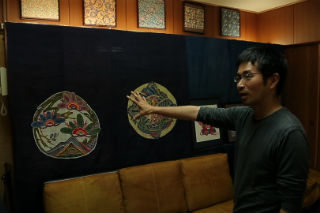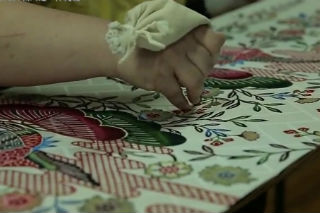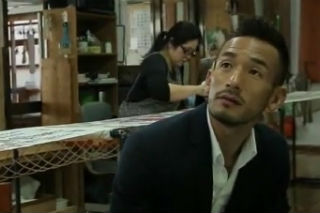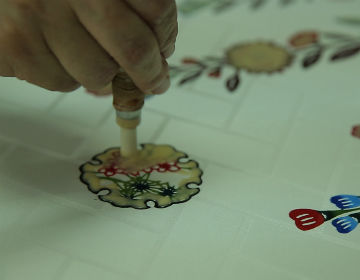Bingata – formerly a royal costume
Bingata is a traditional costume of Okinawa. In Ryukyu Kingdom era, only the royal family was allowed to wear them. Bingata makers were also limited, and Shiroma Bingata Workshop is one of the 3 original Bingata makers. The 16th generation bingata artisan, Eiichi Shiroma, let us see a few floral patterns of Bingata. Looking at it, Nakata commented, ”My image of Bingata is the unique use of yellow and blue colors”. Shiroma stated, ”Yellow is the color only permitted to kings, but blue is used often for Bingata.” There were ones dyed in deep indigo, called Aigata, and they were worn by soldiers. The indigo color was as deep as the color of the ocean.

Technique of making pattern and blurring the design
Shiroma specially showed us ”Ryukyu Indigo Dye Pattern” which he made himself. Yellow and red designs were hand-painted on the indigo stencil pattern. Nakata exclaimed, ”it is really amazing” and admired the beauty of the design and color. Stencil patterns are a must for Bingata. They are used to paint designs on Bingata. Stencils are made with a technique called ”tsukibori”, where patterns are made by punching small holes, one by one, on the paper which will become the template. It takes about a month to make one. At the workshop, a long sheet of fabric was in the process of being painted. ”Kumadori (shading)”, which is the process of putting dark color and blending it to the fabric by blurring, is a unique method of Bingata. ”By using ”kumadori” technique, you can bring out the contrast of strength, creating a three-dimensional effect, and adding a sense of perspective to the design”, said Shiroma. They still use brush made of women’s hair for the blurring procedure.

Beautiful Furisode (kimono) of classical patterns
Shiroma explained to Nakata about the classical patterns such as pine and the ocean, ”pines are typically painted in green, but red or indigo is used according to the interpretation of Okinawa people.” After WW2, Okinawan plants such as hibiscus and bougainvillea were drawn, but the characteristic of classical patterns is that things that do not exist in Okinawa are drawn, like ”yukiwa (snowflake-like circular shape)”. It is said to be the reflection of the royal family’s envy towards the mainland, and people’s interaction with the mainland. Shiroma said, ”You may feel our color scheme is unique, but I hope people will eventually understand the appeal of classical patterns. If you can feel Ryukyu’s history close to you, the classical patterns will start to look better and better.




